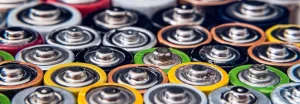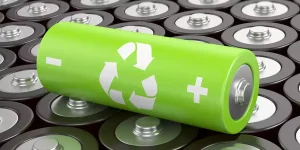Recycling lithium batteries saves up to 60% energy, reduces landfill waste, and cuts production costs by 30%, supporting a sustainable future.
Conservation of Resources
Recycling Valuable Metals
The batteries used in lithium batteries also include lithium, cobalt, nickel, and manganese. Rather than mining more metals from scratch to process these metals, which is particularly environmentally damaging and labor-intensive, it is better to recycle them. For example, 95% of the cobalt and 80% of the lithium in lithium-ion batteries can be recycled, allowing for more efficient extraction of metals from these limited resources and helping to produce new batteries sustainably.
Reducing Raw Materials Demand
Global demand for lithium is expected to surge to more than 1 million metric tons by 2030. Recycling alleviates this pressure by putting used materials back into the cycle. As a result, it reduces the need for further mining activities and their impact on the environment.
Promoting Sustainable Production
This helps create a more sustainable production cycle for lithium battery recycling. Using recycled inputs allows manufacturers to reduce their reliance on virgin resources, which often come from politically unstable locations. This also has the added benefit of supporting environmental sustainability and further isolating the supply chain for a higher degree of robustness and consistency.
Caring for the environment
While mining more lithium and other metals can come at the expense of environmental degradation such as habitat destruction, soil erosion and water pollution, which harms various life forms including plants and wildlife. By recycling, upstream emissions can be limited as well as environmental damage caused by new mining operations. For example, for the production of battery-grade lithium, using recycled resources can reduce CO2 emissions by up to 70% compared to traditional mining processes.

Environmental Protection
Reduce landfills
In most cases, lithium batteries are discarded with other trash and end up in landfills, ultimately releasing toxic materials into the environment. If a single lithium-ion battery is not properly handled, it can contaminate more than 60,000 liters of water. By recycling them, we protect our ecosystems and human health from harmful substances such as lithium, cobalt, and nickel in soil and water sources.
Reduce dependence on fossil fuels
Making new batteries from raw materials consumes much more energy than using recycled materials. Recycling lithium batteries can reduce greenhouse gas emissions by up to 50% because the energy-intensive process of mining and refining raw materials can be avoided. Reducing emissions is essential to mitigate climate change and promote a healthier environment.
Contaminate soil and water
The lead, cadmium, mercury, and other toxic elements contained in lithium batteries pose a serious risk to the environment and public health. When batteries decompose in landfills, these substances can seep into soil and water, contaminating them for years to come. This safely neutralizes and disposes of these harmful substances so they do not threaten and pollute natural resources.
Protecting Natural Habitats
After all, finding battery materials like lithium often means strip-mining the ground, disturbing natural habitats and wildlife. By reducing the need for new mining projects, recycling can help protect natural landscapes and biodiversity. Lithium recycling saves the planet 250 tons of ore for every ton of lithium recovered – so every ton of lithium recovered protects 250 tons of natural habitat.
Energy Savings
Manufacturing with Lower Energy Consumption
Repurposing lithium batteries can significantly reduce the energy requirements of battery manufacturing. Producing new batteries from recycled materials consumes 60% less energy than extracting and processing raw materials. This energy efficiency is critical as demand for lithium batteries continues to increase with the rise of electric vehicles and large-scale energy storage systems for renewable energy.
Maximizing Resource Utilization
Lithium battery recycling is the recovery of valuable metals through methods such as hydrometallurgy and pyrometallurgy. In contrast, hydrometallurgical processes use chemical solutions to dissolve metals and extract them, consuming much less energy. This method is more environmentally friendly than traditional smelting procedures that require high temperatures.
Reduced Dependence on Fossil Fuels
Recycling lithium batteries not only reduces the need for raw material mining and refining, but also reduces the use of fossil fuels. As noted, mining and processing are net depleters of energy resources and are heavily dependent on fossil fuels, thus generating greenhouse gases and having a huge impact on the environment. Many of these negative impacts can be easily reduced through recycling, as this provides a more sustainable and energy-efficient alternative for the environment.
Support for Renewable Energy Integration
Lithium battery recycling helps promote a wider range of renewable energy technologies. These materials can also be recycled and reused in new batteries for storing solar and wind energy, creating a highly efficient closed loop in renewable energy infrastructure. This is a closed loop system designed to reduce overall energy usage, with the goal of transitioning to a world where we power ourselves with cleaner energy.

Economic Benefits
Lower production costs
If one day all batteries need to be replaced due to a 100,000 mile warranty, it can also significantly reduce the price of new batteries. Recycled products often cost less than newly mined and refined raw materials. For example, recycled cobalt is about 30% cheaper than newly mined cobalt. These cost savings can be passed on to customers and help make battery-powered devices cheaper and more environmentally friendly.
Job Creation and Economic Growth
The recycling industry provides jobs and stimulates economic development. Approximately 250 jobs are created for every 10,000 tons of recycled materials in the collection, processing and manufacturing industries. This is not only good for the local economy, but it also further creates new technologies and businesses that contribute to sustainable development.
Reduced Supply Chain Risk
Reduced market volatility for raw materials adds a layer of supply chain stability as we increase the recycling potential of lithium batteries. Political risks in places like the Democratic Republic of Congo, where costs are high, and risks in sourcing raw materials such as lithium can cause production to stall and cause costs to soar. Therefore, manufacturers can reduce these risks by using recycled materials, providing a level of security and cost benefits to the supply chain.
Resource Efficiency Improvement
By joining the process directly into the use cycle, recycling reflects the entire process of optimal resource utilization. It ensures that these metals can still be recycled, rather than being discarded and having their value wasted. For example, one ton of recycled lithium is $8,000 cheaper for manufacturers than newly sourced material. This can reduce production costs and increase corporate profits.
